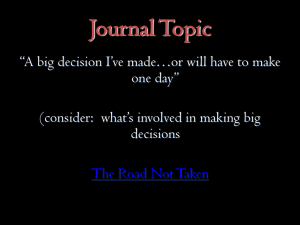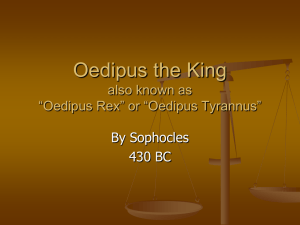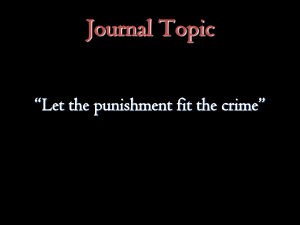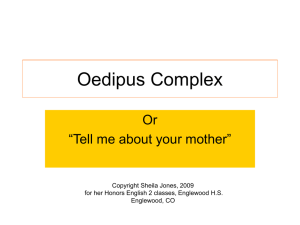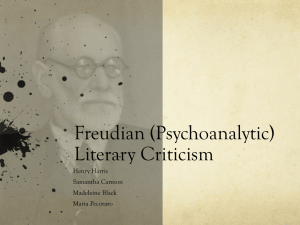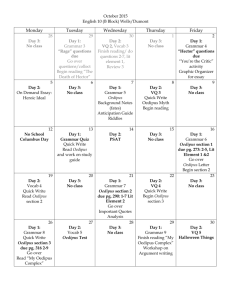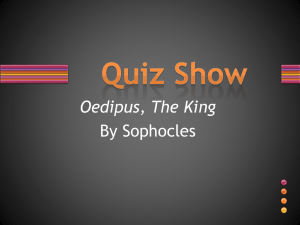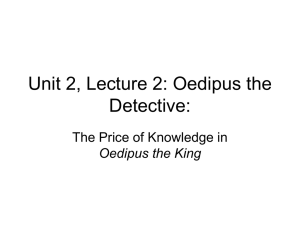Learning Sequence
advertisement
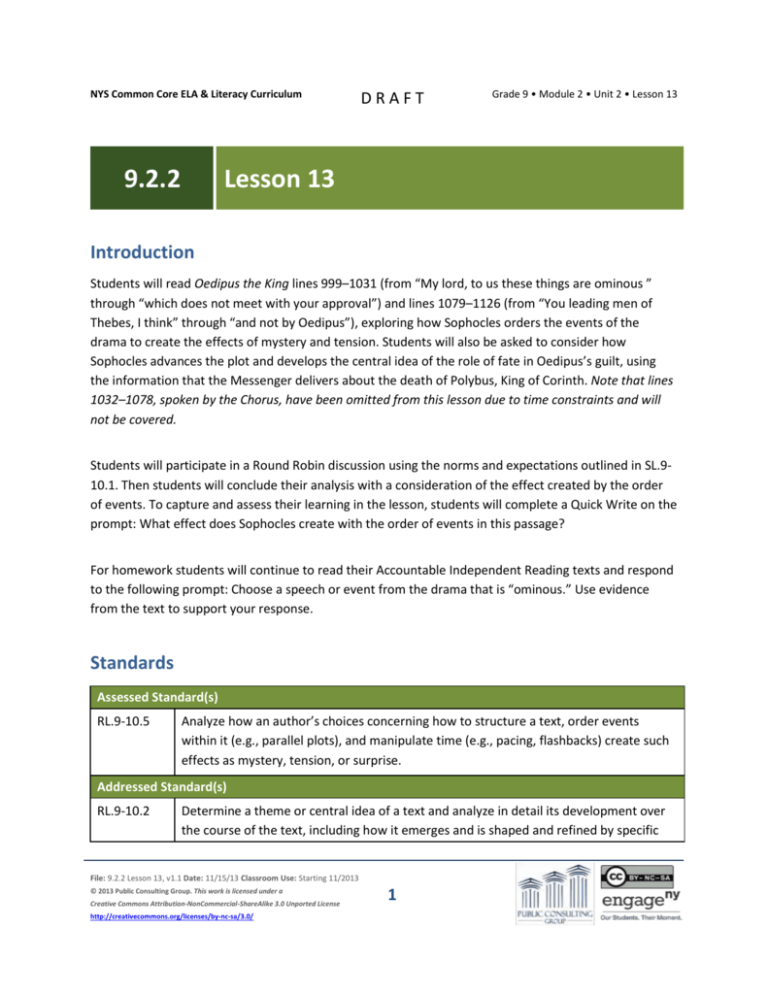
NYS Common Core ELA & Literacy Curriculum 9.2.2 DRAFT Grade 9 • Module 2 • Unit 2 • Lesson 13 Lesson 13 Introduction Students will read Oedipus the King lines 999–1031 (from “My lord, to us these things are ominous ” through “which does not meet with your approval”) and lines 1079–1126 (from “You leading men of Thebes, I think” through “and not by Oedipus”), exploring how Sophocles orders the events of the drama to create the effects of mystery and tension. Students will also be asked to consider how Sophocles advances the plot and develops the central idea of the role of fate in Oedipus’s guilt, using the information that the Messenger delivers about the death of Polybus, King of Corinth. Note that lines 1032–1078, spoken by the Chorus, have been omitted from this lesson due to time constraints and will not be covered. Students will participate in a Round Robin discussion using the norms and expectations outlined in SL.910.1. Then students will conclude their analysis with a consideration of the effect created by the order of events. To capture and assess their learning in the lesson, students will complete a Quick Write on the prompt: What effect does Sophocles create with the order of events in this passage? For homework students will continue to read their Accountable Independent Reading texts and respond to the following prompt: Choose a speech or event from the drama that is “ominous.” Use evidence from the text to support your response. Standards Assessed Standard(s) RL.9-10.5 Analyze how an author’s choices concerning how to structure a text, order events within it (e.g., parallel plots), and manipulate time (e.g., pacing, flashbacks) create such effects as mystery, tension, or surprise. Addressed Standard(s) RL.9-10.2 Determine a theme or central idea of a text and analyze in detail its development over the course of the text, including how it emerges and is shaped and refined by specific File: 9.2.2 Lesson 13, v1.1 Date: 11/15/13 Classroom Use: Starting 11/2013 © 2013 Public Consulting Group. This work is licensed under a Creative Commons Attribution-NonCommercial-ShareAlike 3.0 Unported License http://creativecommons.org/licenses/by-nc-sa/3.0/ 1 NYS Common Core ELA & Literacy Curriculum DRAFT Grade 9 • Module 2 • Unit 2 • Lesson 13 details; provide an objective summary of the text. W.9-10.9.a Draw evidence from literary or informational texts to support analysis, reflection, and research. a. Apply grades 9–10 Reading standards to literature (e.g., “Analyze how an author draws on and transforms source material in a specific work [e.g., how Shakespeare treats a theme or topic from Ovid or the Bible or how a later author draws on a play by Shakespeare]”). SL.9-10.1 Initiate and participate effectively in a range of collaborative discussions (one-on-one, in groups, and teacher-led) with diverse partners on grades 9–10 topics, texts, and issues, building on others’ ideas and expressing their own clearly and persuasively. L.9-10.4.a Determine or clarify the meaning of unknown and multiple-meaning words and phrases based on grades 9–10 reading and content, choosing flexibly from a range of strategies. a. Use context (e.g., the overall meaning of a sentence, paragraph, or text; a word’s position or function in a sentence) as a clue to the meaning of a word or phrase. Assessment Assessment(s) The learning in this lesson will be captured through a Quick Write at the end of the lesson. Students will answer the following prompt based on the close reading (citing text evidence and analyzing key words and phrases) completed in the lesson. What effect does Sophocles create by the order of events in this passage? High Performance Response(s) A High Performance Response may include the following: The effect created by Sophocles’s ordering of events is a release of the fear and tension built through Oedipus’s story and his worries about killing his father, the King of Corinth. The news of the death of the King of Corinth (which Oedipus could not possibly have been involved in) breaks the tension built by Oedipus’s story of the prophecy predicting his involvement in his father’s death and allows momentary relief from the feeling of foreboding that had been steadily increasing throughout the drama. Some students may connect this effect with the thematic development of Jocasta’s shift in attitude towards the gods—Jocasta goes from offering “prayers” (line 1091) to Apollo and being “afraid” (line 1093) to complete confidence that Oedipus will not be caught in the prophecy. She asserts that Polybus was “killed by fate, and not by Oedipus” (lines 1125–1126). File: 9.2.2 Lesson 13, v1.1 Date: 11/15/13 Classroom Use: Starting 11/2013 © 2013 Public Consulting Group. This work is licensed under a Creative Commons Attribution-NonCommercial-ShareAlike 3.0 Unported License http://creativecommons.org/licenses/by-nc-sa/3.0/ 2 NYS Common Core ELA & Literacy Curriculum DRAFT Grade 9 • Module 2 • Unit 2 • Lesson 13 Vocabulary Vocabulary to provide directly (will not include extended instruction) sustain (v.) – to support, hold, or bear up perished (v.) – died or passed away peasant (n.) – a member of a class of persons who are farm laborers of low social rank Lycean Apollo (n.) – the god of prophecy, music, medicine, and poetry, sometimes identified with the sun helmsman (n.) – a person who steers a ship Isthmus (n.) – a narrow strip of land bordered on both sides by water Polybus (n.) – the Corinthian king, Oedipus’s father Vocabulary to teach (may include direct word work and/or questions) ominous (adj.) – foreboding; threatening; a feeling of evil to come Lesson Agenda/Overview Student-Facing Agenda % of Lesson Standards & Text: Standards: RL.9-10.5, RL.9-10.2, W.9-10.9.a, SL.9-10.1, L.9-10.4.a Text: Oedipus the King, lines 999–1031 and 1079–1126 Learning Sequence: 1. 2. 3. 4. 5. 6. 7. Introduction to Lesson Agenda Homework Accountability Masterful Reading Lines 999–1031 and 1079–1126 Reading and Discussion Optional Activity: Round Robin Discussion Quick Write Closing File: 9.2.2 Lesson 13, v1.1 Date: 11/15/13 Classroom Use: Starting 11/2013 © 2013 Public Consulting Group. This work is licensed under a Creative Commons Attribution-NonCommercial-ShareAlike 3.0 Unported License http://creativecommons.org/licenses/by-nc-sa/3.0/ 3 1. 2. 3. 4. 5. 6. 7. 5% 10% 10% 35% 20% 15% 5% NYS Common Core ELA & Literacy Curriculum DRAFT Grade 9 • Module 2 • Unit 2 • Lesson 13 Materials Student copies of the Short Response Rubric and Checklist (refer to 9.2.1 Lesson 1) Student copies of the Speaking and Listening Rubric and Checklist (refer to 9.2.2 Lesson 5) Learning Sequence How to Use the Learning Sequence Symbol 10% Type of Text & Interpretation of the Symbol Percentage indicates the percentage of lesson time each activity should take. Plain text (no symbol) indicates teacher action. Bold text (no symbol) indicates questions for the teacher to ask students. Italicized text (no symbol) indicates a vocabulary word. Indicates student action(s). Indicates possible student response(s) to teacher questions. Indicates instructional notes for the teacher. Activity 1: Introduction to Lesson Agenda 5% Begin by introducing the agenda and assessed standard for this lesson: RL.9-10.5. In this lesson, students will explore how Sophocles orders the events of the drama to build the effect of tension and suspense in the mystery of Laius’s death and develop a central idea. Students look at the agenda. Activity 2: Homework Accountability 10% Instruct students to talk in pairs about how they can apply their focus standard to their text. Lead a brief share out on the previous lesson’s AIR homework assignment. Select several students (or student pairs) to explain how they applied their focus standard to their AIR text. Students (or student pairs) discuss and share how they applied their focus standard to their AIR text from the previous lesson’s homework. File: 9.2.2 Lesson 13, v1.1 Date: 11/15/13 Classroom Use: Starting 11/2013 © 2013 Public Consulting Group. This work is licensed under a Creative Commons Attribution-NonCommercial-ShareAlike 3.0 Unported License http://creativecommons.org/licenses/by-nc-sa/3.0/ 4 NYS Common Core ELA & Literacy Curriculum DRAFT Grade 9 • Module 2 • Unit 2 • Lesson 13 Activity 3: Masterful Reading 10% Introduce the Quick Write assessment (What effect does Sophocles create by the order of events in this passage?). Explain to students that this is the lesson assessment and the focus for today's reading. Students read the assessment and listen. Display the Quick Write assessment for students to see. Have students listen to a masterful reading of the passage from “My lord, to us these things are ominous” through “which does not meet with your approval” (lines 999–1031) and “You leading men of Thebes, I think” through “and not by Oedipus” (lines 1079–1126). Instruct students to read along in their text. Provide the following question to focus student reading: What different emotions do the characters express in this passage? Student responses may include: o o o o The Chorus expresses feeling “ominous” but encourages Oedipus to feel hopeful lines 999– 100). Oedipus senses some “hope” that he’ll “escape disaster” (line 1006). Jocasta is confident of Oedipus’s innocence, but she is concerned about his state of mind because he “has let excessive pain seize on his heart” (lines 1083–1084). She admits to feeling “afraid,” even “terrified” enough to visit Lycean Apollo “with offerings and prayers” that he may “find some way of cleansing what corrupts” them (lines 1089– 1092). Lead a brief discussion of the emotions in this passage. Activity 4: Lines 999–1031 and 1079–1126 Reading and Discussion 35% Direct students to form small, heterogeneous groups. Instruct students to read aloud in their groups lines 999–1014 (from “My lord, to us these things” through “then I’m the one responsible for this”). Then direct groups to discuss the following questions before sharing out with the class: Students read aloud in groups, each reading a role. Then groups discuss the questions that follow. What words or phrases can help you to determine the meaning of ominous in this context? File: 9.2.2 Lesson 13, v1.1 Date: 11/15/13 Classroom Use: Starting 11/2013 © 2013 Public Consulting Group. This work is licensed under a Creative Commons Attribution-NonCommercial-ShareAlike 3.0 Unported License http://creativecommons.org/licenses/by-nc-sa/3.0/ 5 NYS Common Core ELA & Literacy Curriculum DRAFT Grade 9 • Module 2 • Unit 2 • Lesson 13 Students should identify the Chorus’s advice “but you must sustain your hope” to determine that ominous means foreshadowing or foreboding that something bad is going to happen (lines 999–1000). Consider drawing students’ attention to their application of standard L.9-10.4.a through the process of determining word meaning through the use of context clues. Where have Oedipus and the Chorus placed their “hope” (lines 1000–1001)? Why? Students should identify that both the Chorus and Oedipus are hoping that “the servant who was present at the time” of Laius’s murder will be able to prove that Oedipus did not kill Laius. According to Jocasta, this servant said Laius was killed by “several men.” If the servant can confirm this then it is proof that Oedipus (“a single man”) is not the murderer (lines 1010–1013). Instruct students to read aloud in their groups lines 1015–1029 (from “Well, that’s certainly what he reported then” through “I’ll call him here as quickly as I can”). Then direct groups to discuss the following questions before sharing out with the class: Students read aloud in groups, each reading a role. Then groups discuss the questions that follow. According to Jocasta, what key detail in Apollo’s prophecy makes it so that the prophecy does not “fit” the situation? What might this reveal about Jocasta’s primary concern? Student responses may include: Jocasta says that the prophecy cannot be true no matter what the servant says, because the prophecy requires the murderer to be her son. Since Laius killed her son at birth, Jocasta believes that the prophecy cannot come true. Students might infer that it appears that Jocasta is more concerned with the fulfillment of the prophecy, than with the fact that her husband may have killed Laius. Instruct students to read aloud in their groups lines 1078–1094 (from “[JOCASTA enters from the palace and moves to an altar to Apollo…]” through “who on a ship see their helmsman terrified”). Then direct groups to discuss the following questions before sharing out with the class: Students read aloud in groups and discuss the questions that follow. What does Jocasta’s statement “he listens to whoever speaks to him of dreadful things” reveal about her attitude towards Oedipus’s search for answers? File: 9.2.2 Lesson 13, v1.1 Date: 11/15/13 Classroom Use: Starting 11/2013 © 2013 Public Consulting Group. This work is licensed under a Creative Commons Attribution-NonCommercial-ShareAlike 3.0 Unported License http://creativecommons.org/licenses/by-nc-sa/3.0/ 6 NYS Common Core ELA & Literacy Curriculum DRAFT Grade 9 • Module 2 • Unit 2 • Lesson 13 Student responses may include: Jocasta is again criticizing Oedipus’s reliance on prophets and other human messengers to answer his questions. To whom has Jocasta gone for help? What motivates her actions? Jocasta has gone to Lycean Apollo to ask for help to find “some way of cleansing what corrupts [Thebes].” She has gone to ask the gods for help in the problem of the plague and Oedipus’s potential guilt. Students should identify that Jocasta is acting out of fear: “Apollo, I come to you...for now we are afraid” (lines 1089–1093). What comparison is Jocasta constructing through the imagery of this passage? How can this image help you understand who the “we” is in Jocasta’s statement? In Jocasta’s image Oedipus is the “helmsman,” or person who steers the ship, because he is the king and in charge of the direction the city goes. Therefore the “we” is everyone he is in charge of—all the people of Thebes. The “we” in Jocasta’s statement is the entire city of Thebes. It may be helpful to offer a definition of helmsman as “a person who steers a ship.” What might Jocasta’s comparison suggest about Oedipus’s influence over the city of Thebes? Jocasta’s comparison suggests that Oedipus’s fear has a negative influence over the whole city. He is making them “afraid” because he is leading the city into something scary and terrible. Instruct students to read aloud in their groups lines 1094–1121 (from “[JOCASTA sets her offerings on the altar. A MESSENGER enters, an older man]” through “go at once tell this to your master”). Then direct groups to discuss the following questions before sharing out with the class: What impact might the Messenger’s news have on the fears Oedipus expressed while telling the story of his youth in lines 924–998? The Messenger tells Jocasta that “Oedipus’s father [has] died,” and that the people of Corinth want to make Oedipus their new king (lines 1113–1118). Students should return to Oedipus’s story of his youth in lines 924–998 in order to come to the understanding that the death of the King of Corinth (Oedipus’s father) means that Oedipus can return to his “native land” without fear of fulfilling the prophecy that he will kill his father. This prompt encourages students to return to their understanding of Oedipus’s interpretation of Apollo’s prophecy that he would kill his father and marry his mother. Students further develop their understanding through the lens of these new details. File: 9.2.2 Lesson 13, v1.1 Date: 11/15/13 Classroom Use: Starting 11/2013 © 2013 Public Consulting Group. This work is licensed under a Creative Commons Attribution-NonCommercial-ShareAlike 3.0 Unported License http://creativecommons.org/licenses/by-nc-sa/3.0/ 7 NYS Common Core ELA & Literacy Curriculum DRAFT Grade 9 • Module 2 • Unit 2 • Lesson 13 Remind students of their work on the Mid-Unit Assessment, specifically around the idea of fate. Instruct students to revisit the passage and annotate the text for evidence of the development of a central idea. As they annotate for central idea, they are beginning to identify textual evidence that may be used in the End-of-Unit Assessment, which addresses the development of central ideas in the text. This focused annotation supports students’ engagement with W.9-10.9.a, as they draw evidence from the text to use in their writing. Instruct students to read aloud in their groups lines 1120–1126 (from “You there –“ through “and not by Oedipus”). Then direct groups to discuss the following questions before sharing out with the class. How does Jocasta’s attitude towards the gods change with the arrival of the Messenger from Corinth? What motivates this change? Jocasta’s attitude toward the gods has shifted from one of fear and supplication: “Apollo, I come to you...for now we are afraid” (lines 1089–1093) to a denial of their power and importance: “Oh, you oracles of the gods, so much for you” (line 1122). Students should connect Jocasta’s shifting attitude to the fact that her fear of Oedipus’s fulfilling the prophecy has been relieved by the news of the death of Oedipus’s father. If students struggle to make this connection, consider prompting them to revisit their response to the above question: Who has Jocasta gone to for help? What motivates her actions? This question sets students up to answer the lesson assessment question, making a connection between the shifting attitude of Jocasta and the shift in the text that Sophocles’s structural choices create. Instruct students to revisit the passage and annotate the text for evidence of Sophocles’s structural choices, which may be used in the lesson assessment. This focused annotation supports students’ engagement with W.9-10.9.a, as they draw evidence from the text to use in their writing. What impact might the Messenger’s news have had if he had arrived from Corinth before Oedipus told the story of his youth? Student responses may consider how the Messenger’s news may have impacted the way in which Oedipus told his story, or whether he would have shared it at all. If the Messenger had arrived first, Oedipus would have known before he told his story that Polybus was dead and he had not fulfilled the prophecy. If the Messenger had arrived before Oedipus told his story, Oedipus would not have been scared of “kill[ing his] father, Polybus” because he would have known Polybus was already dead. Oedipus would not have scared the Chorus with these “ominous” things or made Jocasta “afraid.” File: 9.2.2 Lesson 13, v1.1 Date: 11/15/13 Classroom Use: Starting 11/2013 © 2013 Public Consulting Group. This work is licensed under a Creative Commons Attribution-NonCommercial-ShareAlike 3.0 Unported License http://creativecommons.org/licenses/by-nc-sa/3.0/ 8 NYS Common Core ELA & Literacy Curriculum DRAFT Grade 9 • Module 2 • Unit 2 • Lesson 13 This question transitions student analysis from considering how the Messenger’s news influences Jocasta’s shift in attitude toward the gods to exploring the effect created by Sophocles’s choice to have the Messenger deliver the news at this point in the drama. Prompting students to consider how else Sophocles might have ordered these events establishes the role of authorial choice in how events of the play unfold, and prepares students to consider the reasons behind this choice and the effects that it creates. Instruct students to revisit the passage and continue to annotate the text for evidence of Sophocles’s structural choices, which may be used in the lesson assessment. Optional Activity 5: Round Robin Discussion 20% Explain Round Robin protocols. Instruct students to arrange themselves into two concentric circles. Each circle should contain the same number of students, creating pairs between the two circles. Student pairs should be facing each other. The Round Robin begins with each student in the inner circle briefly discussing their answer to the following prompt: What effect does Sophocles create by the order of events in this passage? Each student’s counterpart on the outer circle first listens and then responds with his or her own brief answer to the focusing prompt. Then, at the teacher’s direction, students in the outer circle rotate to the right one spot and repeat the protocols established with a new partner. This Round Robin will include three rotations. Circulate and observe student discussions, focusing specifically on how students apply the norms and expectations outlined in SL.9-10.1 and the displayed Speaking and Listening Rubric. Remind students to refer to their Speaking and Listening Rubric and Checklist as they engage in the discussion. Remind students that these discussion skills scaffold the discussion-based End-of-Unit Assessment in Unit 3. In addition to the discussion, student comprehension of the prompt will be captured through a written closing statement at the end of the activity. The purpose of this exercise is for students to practice building on others’ ideas and expressing their own with others who have diverse perspectives. This exercise also has the added benefit of preparing students to write their brief written response through brainstorming and oral processing. File: 9.2.2 Lesson 13, v1.1 Date: 11/15/13 Classroom Use: Starting 11/2013 © 2013 Public Consulting Group. This work is licensed under a Creative Commons Attribution-NonCommercial-ShareAlike 3.0 Unported License http://creativecommons.org/licenses/by-nc-sa/3.0/ 9 NYS Common Core ELA & Literacy Curriculum DRAFT Grade 9 • Module 2 • Unit 2 • Lesson 13 Students engage in a Round Robin discussion in response to the focusing prompt. Students conversations should include some of the following details: o o o The effect created by Sophocles’s ordering of events is a release of the fear and tension built through Oedipus’s story and his worries about killing his father, the King of Corinth. The news of the death of the King of Corinth (which Oedipus could not possibly have been involved in) breaks the tension built by Oedipus’s story of the prophecy predicting his involvement in his father’s death and allows momentary relief from the feeling of foreboding that had been steadily increasing throughout the drama. Some students may connect this effect with the thematic development of Jocasta’s shift in attitude towards the gods—Jocasta goes from offering “prayers” (line 1091) to Apollo and being “afraid” (line 1093) to complete confidence that Oedipus will not be caught in the prophecy: “killed by fate, and not by Oedipus” (lines 1125–1126). The effect of the Corinthian King’s death “sustains” the audience’s “hope,” just as the Chorus told Oedipus to do, despite the fact that his story of a dreadful prophecy moments before made things seem very “ominous.” Activity 6: Quick Write 15% Instruct students to respond briefly in writing to the following prompt: What effect does Sophocles create by the order of events in this passage? Remind students to use the Short Response Checklist and Rubric to guide their written responses. Display the prompt for students to see, or provide the prompt in hard copy. Students independently answer the prompt using evidence from the text. See the High Performance Response at the beginning of this lesson. Activity 7: Closing 5% Display and distribute the homework assignment. For homework, instruct students to respond in writing to the following prompt: Choose a speech or event from the drama that is “ominous.” Explain your selection with supporting evidence from the text. Remind students to use the Short Response Checklist and Rubric to guide their written responses. File: 9.2.2 Lesson 13, v1.1 Date: 11/15/13 Classroom Use: Starting 11/2013 © 2013 Public Consulting Group. This work is licensed under a Creative Commons Attribution-NonCommercial-ShareAlike 3.0 Unported License http://creativecommons.org/licenses/by-nc-sa/3.0/ 10 NYS Common Core ELA & Literacy Curriculum DRAFT Grade 9 • Module 2 • Unit 2 • Lesson 13 Also for homework, instruct students to continue their Accountable Independent Reading through the lens of the focus standard they have chosen and prepare for a 3–5 minute discussion of their text based on that standard. Students follow along. Homework Choose a speech or event from the drama that is “ominous.” Use evidence from the text to support your response. Continue to read your Accountable Independent Reading text through the lens of a focus standard of your choice and prepare for a 3–5 minute discussion of your text based on that standard. File: 9.2.2 Lesson 13, v1.1 Date: 11/15/13 Classroom Use: Starting 11/2013 © 2013 Public Consulting Group. This work is licensed under a Creative Commons Attribution-NonCommercial-ShareAlike 3.0 Unported License http://creativecommons.org/licenses/by-nc-sa/3.0/ 11
